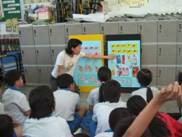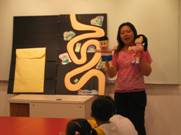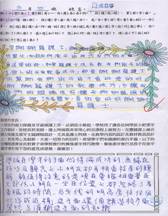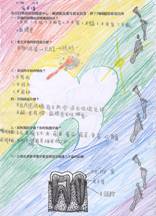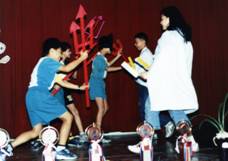 ¡GFor Grade I and II, we have found that enlarged books used in class appeal to them a lot. Also, we have some toys modeling on the relationship between toothbrushes and mouths. When some kids use ¡§toothbrush cars¡¨ driving through the mouth printed in the enlarged books, some other kids would say ¡§Use smaller cars. It¡¦s easier to get around.¡¨ In the toothbrush car game, we know that kids have already recognized the benefit of using smaller toothbrushes. Second, small kids love puppets. We sometimes use a puppet, a toothbrush and the enlarged book to tell stories about tooth care. They enjoy it a lot. You¡¦ll see kids holding their toothbrushes talking to the puppet. Third, at lunchtime, we use toothbrushes to brush small tomatoes to see if the bristles are soft enough.
¡GFor Grade I and II, we have found that enlarged books used in class appeal to them a lot. Also, we have some toys modeling on the relationship between toothbrushes and mouths. When some kids use ¡§toothbrush cars¡¨ driving through the mouth printed in the enlarged books, some other kids would say ¡§Use smaller cars. It¡¦s easier to get around.¡¨ In the toothbrush car game, we know that kids have already recognized the benefit of using smaller toothbrushes. Second, small kids love puppets. We sometimes use a puppet, a toothbrush and the enlarged book to tell stories about tooth care. They enjoy it a lot. You¡¦ll see kids holding their toothbrushes talking to the puppet. Third, at lunchtime, we use toothbrushes to brush small tomatoes to see if the bristles are soft enough.
For Grade III and IV, we encourage students to ask a lot of questions and work in groups to look for the answers to the questions they have posed. Students would go to the library to make a research themselves or talk to their dentists or our school nurse. In this way, they are synthesizing community and school resources. We sometimes design some games for the dental health education. Students are thus learning knowledge by delight. Our teaching is never restricted to the classroom. We would, for example, ask students to pick up pebbles to make a tooth model.
For Grade V and VI, we ask students to make their own enlarged version of a tooth care book. They give personal experience in the book. For example, one group tells how someone breaks his tooth in a collision and how to take care of it in such an emergency. Furthermore, we would ask students to act out what happens in the book they have designed. Both the actors and the audience all have a lot of fun acting and watching them. Knowledge of dental health is thus deep-rooted in the long-term memories of the students in such a teaching-by-delight way.
